#french alpine goat
Text

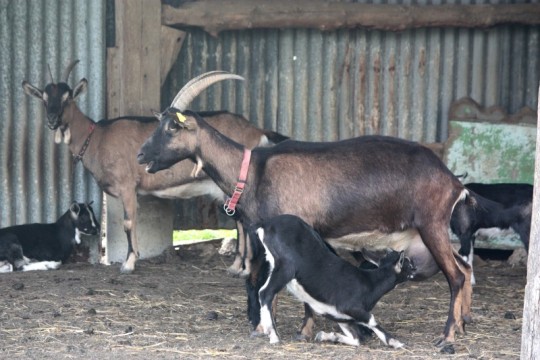








The Alpine, also known as the french alpine or alpine dairy goat is a breed of domestic goat which originated in the French and Swiss Alps. They are well known for there lean meat, docile temperament, large high quality milk output, and long lactation. Said milk is low in fat and high in sugars, making alpines highly prized and popular dairy goats. They are hardy animals that thrive in a variety of climates, and can be trained to be reliable pack animals. Females reach around 28 to 32 inches (70 to 80inches) tall at the withers and 110 to 155lbs (55 to 70kgs) in weight whilst males are 32 to 40inches (80 to 100cms) tall at the withers and weigh 170 to 220lbs (77 to 100kgs). They are a slimmer, medium sized, graceful yet strong breed characterized by there deep chest, wide hips, straight legs, voluminous udders, straight nose, horns, and large erect ears. The color pattern may range from pure white through shades of fawn, gray, brown, black, red, bluff, piebald or various shadings or combinations of these colors. Both sexes are generally short haired, but bucks usually have a roach of long hair along the spine. The beard of males is also quite pronounced, females may also sport beards. Breeding may occur year round and after a 145 to 155 day pregnancy a mother alpine goat may give birth to 1-2 kids. Under ideal conditions an alpine goat will reach sexual maturity at around 4 to 6 months of age and may live up to 18 years.
#pleistocene pride#pleistocene#pliestocene pride#pliestocene#cenozoic#goat#goats#french alpine goat#alpine goat
2 notes
·
View notes
Note
I need your expertise HP, I’ll be in France next Spring, what French cheese should I try?
All of them.
Take advantage of finding the younger unpasteurized ones you can't find here in the states. Brie de Meaux. Reblochon. Camembert.
I do love big smelly wash rinds..Soumaintrain. Epoisses. Timanoix. Munsters and Livarot.Tappist abbay cheeses
I'm a whore for Loire Valley goat cheeses. Crottin or Sells sur Cher. Lingot from the Pyrennes.
Raw Brebis Pyrennes is a favorite.
Or Cantal, Salers, or Lagiuole
Alpines like Abondance and Beaufort
Or hundreds of others...have fun! I'm jealous

39 notes
·
View notes
Note
After properly waking up (and finally not having any more wake up for the race till Vegas, WE DID IT), here’s a bit if my analysis of the race, which is my favourite so far, a bit even more than Japan, because of its chaos and emotions
First, hometown hero. Zhou was not driving the car based on anything, other than pure emotion. He was living his dream in a way that I wish everyone could one day, honestly I’ve been emotional since that sprint shootout when he reached SQ3 and so proud that he is making history and realising his dream. On a more technical aspect, Sauber meed to get their shit together, the car is not good, and the fact that we celebrate them having a pit stop less than 5 seconds is so disappointing. They need to get it together to get points and be in that fight.
Nico Hulkenberg is a Goat, there I said it. The way he is taking that Haas places is just phenomenal, and honestly I think he deserves a proper team, and he so deserves to be on a podium, more than just one time. Kevin had an okay race, except of course, for ruining Yuki’s. But if K-Mag did not get his shit together, Ollie very easily could replace him next year, especially since Komatsu is no Guenther, and he will not have the mentality of fucking the youngster over.
RB’s weekend was going very well, in terms of race not sprint, that sprint was not great, but the circuit is not for them, and it’s Yuki’s first time there, so an off weekend (a normal one) was not going to be the worst thing in the world. But the way the race played out, with Kevin knocking Yuki out if the race with a stupid crash, destroying his race, and then Fernando locking up and hence lance knocks Daniel out with a crash that was so easy to prevent if he was focused on the car in front of him instead of the apex during the time of a safety car returning to the pit, the pack all close together and still getting up to speed. Yeah, that sucked for them, Daniel especially who was in contention of points. But other than that, the strategy was kind if fucked up, but it could have been saved at the end if it were not for both Astons.
As I said last race week, the Alpines are slowly but surely getting better. They started having pace today, and even if it were anyone else other than Nico, Esteban could have gotten points, but Nico Masterclass. This season is showing who is the leader of the French team, and it’s Estie. He’s extracting every single once if pace in that car, even if there isn’t any, and is showing that he’s the one. Pierre, tbh is getting better as well, but not to the Esteban level of almost Q3 and potentially points. Actually I feel like Pierre has not given much (expect for the Dutch GP last year) where he’s showing that the move to Alpine was a right choice for him.
George is impressive, and I hate to say it, more that Lewis is. He’s getting out everything out of the car, and I feel is working harder to keep Mercedes alive this season, with both the sprint and the race, with snagging that last point in the sprint from a shit quali, to an impressive performance in a track that doesn’t suit the new Mercedes cars, and trying his damn best all weekends, I’m genuinely impressed and proud of him, especially with the way he’s working to show the team that he could be a leader. Meanwhile I feel like Lewis is just trying to finish the year to go to Maranello, granted he’s trying, but I feel George is working harder.
McLaren, I have mixed emotions, Oscar was okay, again his first time on that track, but when compared to Lando, he did okay, not great. Lando was actually phenomenal, pulling that one stop, and doing so well in that, holding Checo back almost half of the race, he should be extremely proud of himself. And on that note, I love seeing Adam Norris down when Lando and Max are on the podium, I feel he’s proud of his son, but also Max, and I am just so happy and giddy
Ferrari, Idk what to feel. On one hand, Charles was phenomenal, but on the other, all these plans just give me anxiety, again, pulling that one stopper, but Checo got him, in a track that doesn’t feel of seem suited for the car, actually impressed. Carlos however, seemed to have gotten in his head, from saying yesterday that if he got Max he would have won the sprint, to the unnecessary fight with Charles on the sprint, he’s getting cocky, and that won’t help his situation of getting into a good team next year.
Red Bull, I AM SO FUCKING IMPRESSED AND I CANNOT BEGIN TO SAY HOW MUCH I LOVE THIS TEAM AND AM SO PROUD OF THEM. Max was just phenomenal, despite the sprint quali that was apparently not so great because the car was not set up for rain. Simply because the forecast didn’t show much rain. As for the race, damn I can’t believe the team did that, 2 perfect double stacks with a total pit stop time of 8 for changing 16 tyres. The pit crew are the actual heroes today. Checo you could see that he’s disappointed, and that shows how much he’s comfortable in the car, and how at one he is with the team, in addition to knowing the stakes at hand. But nonetheless, he was phenomenal in a weekend that according to him, wasn’t great.
But yeah, this race was just amazing and chaotic and tbh, I love this chaos. And up next Miami, what will each one do, especially since Max never got pole there (just like Jeddah). We shall see
(Also, hoping the girls next race have a good weekend, especially the Red Bull girls, not because they’re Re Bull, I’ve been impressed by Hamda since COTA last year, and I called she’ll be the RBR girl)
I have nothing to add to any of this, so I'll just leave it in all its glory as it is. ❤️
16 notes
·
View notes
Text
The Creatures of Yuletide: The Hidden History of the Christmas Goats
How Christians allowed pagan goat symbolism into their sacred holidays

Back in 2020, I started a series of posts here called Creatures of Yuletide, diving into the strange world of the creatures and magical figures that are said to appear during the holidays. However, there were some creatures and some interesting pieces of lore that I left unexplored, so now that I’m on my break from college, I’m thinking about bringing the series back for this holiday season.
I consider this piece a companion to my posts about Krampus, the Yule Goat, and the Companions of St. Nicholas, explaining things that I got wrong or thought were left unclear.
Let's start with my biggest complaint about the portrayal of Krampus in modern media: Why is he always a villain?
Originally an obscure character of regional European traditions, Krampus exploded in popularity in the late 2010s, quickly becoming a stock villain in cheap Christmas horror films, usually portrayed as a common demon or as a demon doppelganger of Santa Claus.
The fact is, that the tradition of Santa Claus started with St. Nicholas appearing on the eve or right on the day of his feast distributing some sweets, oranges, and nuts to children. However, these treats were only for good children. The bad children received a visit from a scarier and more threatening figure that would follow the saint. Usually, this figure would be represented by someone in fur clothes, with horns, and with a mask or a painted face. Depending on the region and country the identity of this dark companion varied.
In Austria, he was our demon Krampus

In Germany, he was a scary man called Knecht Ruprecht.

In French, he was Père Fouettard, Father Whipper, a dark figure connected to a butcher that killed three children in St. Nicholas’ legends.

In the low countries he was the controversial Zwarte Piet, where instead of a demon or a creepy man covered in soot, he’s a black servant boy, represented by a white person in blackface.

If you take Krampus' depiction at face value it’s easy to see him as a villain, since his and all the other companions’ shtick is to threat bad-behaved children with physical punishment and dragging them to a worse place. But if you look at the origins of the tradition you see a more interesting and much more nuanced view.
The people of the Alpine region and central Europe, in general, had a tradition of dressing in fur clothes and wearing wooden masks with horns. That was deeply connected with Frau Perchta, another dark yuletide figure from the Alpine region that was a goddess before Christianity arrived.
Perchten is the plural of Perchta. Originally, the word referred to female masks representing her, but the name come to refer to the animal masks worn in parades and festivals in the mountainous regions of Austria.
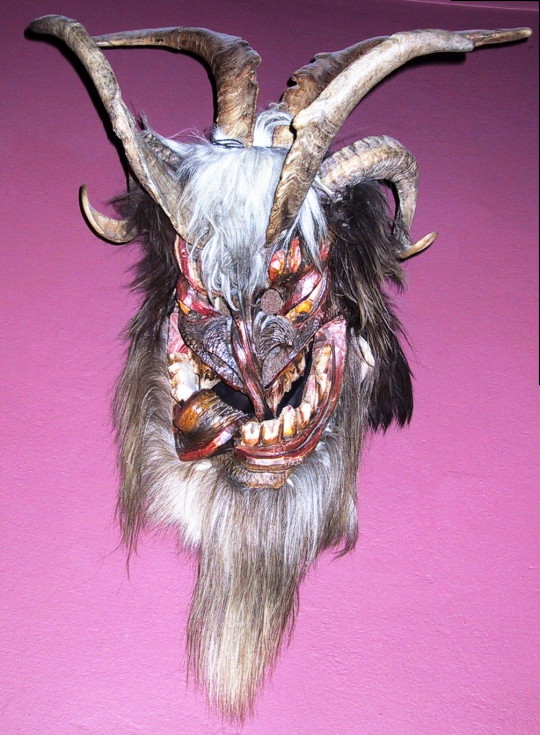
People would masquerade as these devilish figures and march in processions known as Perchtenlaufs. The Church didn’t like these creatures and tried many times to ban these practices, but due to the sparse population and the rugged environments within the region, the ban was useless.
Now depicted as a simple Christmas ornament in Scandinavian countries, the Yule Goat and similar other figures were probably offsprings of this tradition.
When the Christians showed up, small bits of these traditions remained, as an act of resistance, but little by little these people started adding Christian contexts to them, and Christians begrudgingly accepted them.
St. Nicholas is the patron saint of children. His saint day falls in early December, which helped strengthen his association with the Yuletide season. A seasonal play that spread throughout the Alpine regions was known as the Nikolausspiel, "Nicholas play". In these plays, St. Nick would make questions about morality and reward children for their scholarly efforts. Eventually the Perchtenlauf, in an attempt to pacify the Church, introduced Saint Nicholas and his set of good morals.
During the 17th century, in Sweden, it was the costume that during Christmas or the Epiphany (The Three King’s Day), young men in costumes would walk between houses singing songs, enacting plays, and performing pranks. The Yule Goat would often appear in these pranks, usually as a scary figure demanding gifts.
Eventually, these animal costumes soon became boogeyman figures that would follow St. Nicholas in punishing bad children. From place to place, the shape and identity of the companion changed, in some places staying a demon-like creature like Krampus, in others becoming fully human, like Zwarte Piet and Knecht Ruprecht.
It’s also important to point out that in some places, the goat creature absorbed St. Nicholas completely and became the gift-bringer himself. That’s the case with the Yule Goat. During the 19th century, men would often dress as goats to give gifts to their families. In Finland, to this day, the word for Santa, Joulupukki, translates to "Christmas goat" or "Yule Goat".

So why did all of these people dressed like goat monsters during wintertime?
Protection of course!
Thanks to electricity and heating we tend to forget how unforgiven winters in Northern Europe were. Winter was considered a time of darkness and death, and similar to Halloween, there was this belief that during winter the barrier between the worlds weakened. It was believed that ghosts and other evil spirits and entities could come to our world. There were several stories about entire spectral legions bewitching and spiriting away people in the dead of night. People dressed in these masks and costumes to scare these evil spirits.
In the 16th century, the Perchten took two main forms: Schönperchten, "beautiful Perchten", or the Schiachperchten, "ugly Perchten”. The beautiful Perchten came during the twelve nights of Christmas and festivals to bring luck and wealth to the people. The ugly Perchten had fangs, tusks, and horse tails that were used to drive out demons and ghosts. Men dressed as the ugly Perchten during this time and went from house to house driving out bad spirits.
The Norwegian had the tradition of “Julebukking” or more correctly, “to go julebukk” (Gå julebukk). One man or many men from the community would dress in a goat mask and fur cape to represent the ghosts of a winter night. After that, they would go “trick or treating” from door-to-door receiving gifts from the towns folk to thank them for protection and keeping the winter ghosts at bay
Today, in some parts of Finland, the custom persists of people performing in goat costumes in return for leftover Christmas food.
From the Smithsonian Magazine: A man dressed in a traditional Perchten costume and mask performs during a Perchten festival in the western Austrian village of Kappl, November 13, 2015. Each year in November and January, people in the western Austria regions dress up in Perchten (also known in some regions as Krampus or Tuifl) costumes and parade through the streets to perform a 1,500 year-old pagan ritual to disperse the ghosts of winter. (DOMINIC EBENBICHLER/Reuters/Corbis)

Krampus and all the other Christmas goats aren’t evil. They are wild, but not evil. They aren’t even demons, that’s part of the Christianization and the demonization of them. In the proper context of their cultures, they are defenders of people, having their origins in a tradition that consists of scaring away malevolent winter spirits.
The idea of Krampus as the last remnant of a pagan world, protecting people from evil spirits that the modern world forgot existed, to me, sounds much more original than another cheap Christmas horror movie where Krampus is the bad guy.
@ariel-seagull-wings @thealmightyemprex @amalthea9 @tamisdava2
117 notes
·
View notes
Text
Mythological animals that I think should be used for Arknights character designs
I posted this on Reddit, might as well post it here too.
Arknights has a lot of myth-inspired characters already beside the obvious dragons, angels and devils: We have Pegasi (the Nearl family), Griffins (Archetto). Hippogryph (Hellagur), Phoenixes (Fiammetta), Kukulkán (Ho'olheyak), Cerberus (Ceobe), Typhon (well... Typhon)... you get the picture.
So... why not add some more mythical animal-inspired designs? Here are some that I think would be awesome to have in the game.
Cadejo:

What they are: The Cadejo (Spanish pronunciation: [kaˈðexo]) is a supernatural spirit that appears as a dog-shaped creature with blue eyes when it's calm and red eyes when it's attacking. It roams isolated roads at night, according to Central American folklore of indigenous origin. In some variations of the myth, there is a good white cadejo and an evil black cadejo. Both are spirits that appear at night to travelers: the white cadejo protects them from harm and danger during their journey, while the black cadejo (sometimes an incarnation of the devil) tries to kill them.
What I think would be cool: A Perro Dollkeeper that switches between "white" and "black" mode in battle, giving some really nice flavor to the "doll" mechanic. Bonus point if HG goes the Archetto/Ho'olheyak route and give them Sarkaz or Caprinae horns while still having them be of Perro race, as lots of Cadejo artwork represents them with goat horns and/or hooves in line with the whole devil aspect of the legend.
Kamaitachi:

What they are: Kamaitachi (鎌鼬) is a Japanese yōkai often told about in the Kōshin'etsu region. They appear riding on dust devils and they cut people using the nails on both their hands that are like sickles. One would receive a sharp, painless wound. The name is a combination of the words "itachi" meaning weasel, and "kama" meaning sickle. In the Musashi region and Kanagawa Prefecture, they are called "kamakaze" (鎌風, "wind sickle"), and in the Shizuoka Prefecture they are called "akuzen-kaze" (悪旋風, "evil whirlwind").
What I think would be cool: Seriously, why do we not have an Anaty operator based on these guys yet? Why wasn't Shirayuki one? It is not like Arknights has not based characters on yōkai before (Suzuran and Utage immediately come to mind), so where's our sickle weasel at?
Tatzelwurm:
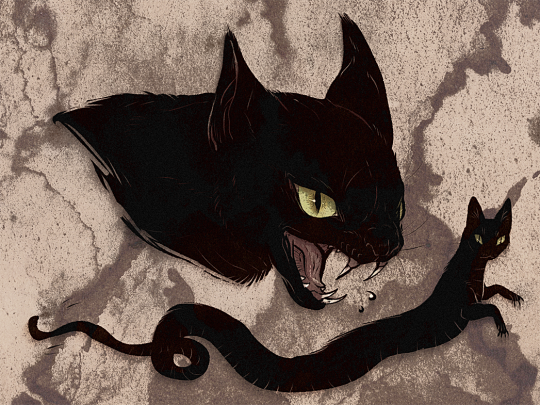
What they are: In the folklore of the Alpine region of south-central Europe, the Tatzelwurm, Stollenwurm, or Stollwurm is a lizard-like creature, often described as having the face of a cat, with a serpent-like body which may be slender or stubby, with four short legs or two forelegs and no hindlegs. The creature is sometimes said to be venomous, or to attack with poisonous breath, and to make a high-pitched or hissing sound. Anecdotes describing encounters with the creature or briefly described lore about them can be found in several areas of Europe, including the Austrian, Bavarian, French, Italian and Swiss Alps. It has several other regional names, including Bergstutz, Springwurm, Praatzelwurm, and in French, arassas.
What I think would be cool: ...okay, I will be honest, I just find the idea of a lizard or serpent-tailed catgirl or catboy really cute (Bonus points if they have cute venomous little fangs). Yes, the idea of putting serpent tails were you wouldn't expect to find them has already been used for both Utage and Ho'olheyak, but not only are both of those examples also based on mythology (The Nue for Utage, Kukulkan/Quetzalcoatl for Ho'olheyak), but their designs also seem to be decently popular with the fandom, so why not repeat the formula?
Simurgh:
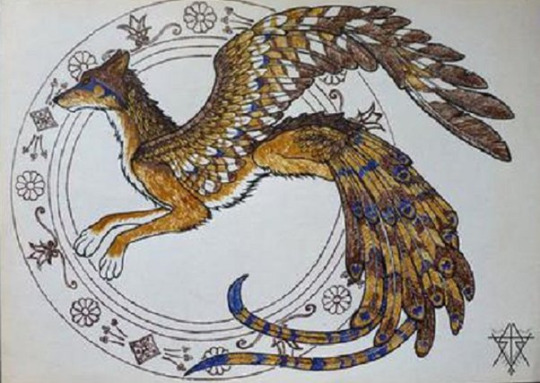
What they are: The simurgh (/sɪˈmɜːrɡ/; Persian: سیمرغ, also spelled simorgh, simorg, simurg, simoorg, simorq or simourv) is a benevolent, mythical bird in Persian mythology and literature. The Simurgh is depicted in Iranian art as a winged creature in the shape of a bird, gigantic enough to carry off an elephant or a whale. It appears as a peacock with the head of a dog and the claws of a lion – sometimes, however, also with a human face.
What I think would be cool: As with the Tatzelwurm, I just want to see what HG could design based on this. There's no doubt in my mind that such a character would have to be a Liberi, just like Ho'olheyak, Archetto and Hellagur before it. I want HG to give us what initially seems like a new Perro or Lupo waifu, fluffy wolf/dog ears and tail, with just a easily missable peacock feather on her hair to foreshadow her true inspiration... and then when the character actually comes out they reveal her as a Liberi seemingly out of nowhere, big majestic Simurgh on her E2 art background, all Lupoknights players utterly jebaited. Let's keep this trend of weird Liberi going, please!
19 notes
·
View notes
Text
f1 teams problems
-RBR: Never had a strong stable line up, team principal's a dannyric merchant, ugly racing suit but nice helmet, one controversial WDC that continues to be a blot to their name, one waste of rocketship (the driver can't drive. i'd steal it and paint it black for george fr)
-Mercedes: someone tell 'em to move on already!, shit PR strategies & social media marketing is bad BAD (peak cringe), #MentalHealthIsImportant but at the same time turns a blind eye towards the hate to one of their driver, allergic to appealing a penalty/stewards' decision, TP is constantly on a childish tantrum about AD21
-McLaren: one of their driver didn't have the balls to fight and that's why he never win even if he could, ugly racing suit, constant team orders to let the not winning driver past
-Ferrari: 'more like a national institution than a sports team'-Christian Horner, 2023 (he spilled), manchester united of F1, one of their driver needs to learn to stop bitching + being a dick on track, none of the engineers can engineer (esp their strategy + race engineer)
-Williams: Mercedes' Alpha Tauri (sometimes but they are better now), no money (they're better now)
-Alpha Tauri: 'we will run a Red Bull .... next year' = still sucks, graveyard/waiting room for red bull juniors, red bull's sacrificial doll sometimes
-Alfa Romeo: shit car ok driver, they're just there, jimmy neutron (their reserve driver) needs to stop liking hate about their driver (like ok theo u deserve a seat but let's not do that 😞)
-Haas: they're just there for the ride each week, riding too much on their TP's fame (recently better PR with KMag's interaction with his daughter)
-Alpine: THE GIRLS ARE FIGHTING, french, hired jack doohan to make up & hide their drivers' issues with e/o
-Aston Martin: 🤑 money money money, don't know how to protect their driver (lance) against hate, alonso carried too much, GOAT in the beginning FLOP at the end, their reserve driver should watch what he likes/retweet/post
4 notes
·
View notes
Note
smash or pass driver pairings edition:
Alpine 2022 (alo, oco)
Aston martin 2022(str, vet)
Williams 2021 (lat, rus)
1. pass ugly french fucks
2. smash but seb pre headband and like when his hair was proper curly w his little cute front fringe too
3. pass goatifi he’s too much of a goat can’t be smashing important goods, smash georgey
smash or pass current or former f1 drivers
0 notes
Text
The makings for a perfect day

The Alpines for example were taking almost as much time from the Mercs there as the Red Bull. It wasn’t just the Red Bull the Merc was struggling against there, it was several other ostensibly slower cars too. There was just no getting around that hard fact. It never got any closer than 0.18s through just that short sequence, and began the weekend even further off than that. The overwhelming part of that advantage came from the exit of Turn 2 to the banked entry of Turn 3, which is effectively all one sequence.įor whatever reason, the Mercedes just refused to work through there. Dressing is best served at room temperature.There were a couple of moments where Verstappen’s victory might have got away from him – probably the biggest wobble being his less than perfect lap which only just secured him pole in a car in which he otherwise had around three tenths advantage. You could substitute feta or goat cheese. Cotija is a crumbly, sharp Mexican cheese. Grilled or fire-roasted corn will add additional flavour. TIPS: Instead of canned corn, you can use 1 1/2 cups (375 mL) thawed frozen corn kernels or cooked fresh corn in this recipe. Cover and refrigerate until chilled, for at least 1 hour before serving. Arrange beans, jicama, corn, bell pepper and avocado side by side on top of lettuce. Spread lettuce evenly across a large serving platter. 1/2 cup (125ml) freshly squeezed lime juiceĭressing: In a small bowl, whisk together lime juice, olive oil, cilantro, hot pepper flakes, garlic and honey.1 yellow or red bell pepper, seeded, cored and diced.1 can (14 to 15 oz/398 to 425 mL) corn kernels, drained.1 can (14 to 19 oz/398 to 540 mL) black or pinto beans, rinsed and drained.This is a wonderful vegetarian meal but can be topped with chicken or steak as well. A citrus marinade refreshes these chopped veggies. Serves 4-6.įresh goodness and colour are at the heart of this fresh chopped salad. Ladle into individual bowls and garnish with equal amounts of tortilla chips, avocado and green onion. Reduce heat to low and simmer for 10 minutes. Cover and bring to a boil over medium heat. Cover and cook until onion is softened, 4 to 6 minutes. In a large pot, heat remaining oil over medium heat. Transfer chicken to a cutting board and let cool. Add chicken and cook, turning once, until no longer pink inside, 6 to 8 minutes per side. 4 green onions, green parts only, minced.2 cups (500ml) broken corn tortilla chips.1/2 cup (125ml) freshly squeezed lime juice (4 to 5 limes).Layers of garlic and lime embrace the fresh avocado garnish - a perfect soup for warm summer months. There is a light citrusy flavor that you will love in this hearty chicken soup. Here's a selection of recipes from Coffeen's book that are bound to put the Ole! into your taste buds. In addition to delicious recipes and fool-proof tips, Coffeen's book covers fascinating historical information about the evolution of Mexican cuisine-from its original roots in the Aztec diet to its introduction into North American cuisine through Hispanic influence. This may explain why everyone seems to be celebrating the famous Mexican holiday of Cinco de Mayo this weekend, which commemorates the Mexican army's victory over French forces during the battle of Puebla in 1862, (although I think any day's a great day to enjoy a comfort cuisine made up of bold flavours, simple techniques and wonderful ingredients!)Ĭookbook author Kelley Cleary Coffeen, in her newest tome, 200 East Mexican Recipes: Authentic Recipes from Burritos to Enchiladas (Robert Rose $24.95), offers the basics and foundations of authentic Mexican cooking with recipes that are no-fuss, creative and just plain fun. will outpace all ethnic groups over the next 40 years - which means Mexican cuisine alone is coming into a new era of appreciation and understanding. Research shows Hispanic population growth in the U.S. Manage Print Subscription / Tax Receiptįrom burritos to enchiladas - Mexican food is fast becoming a hot commodity.

0 notes
Photo




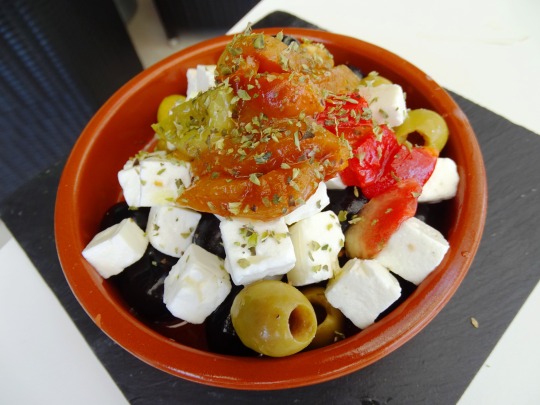


Goats Cheese Day
To celebrate the wonders and benefits of this distinctively acidic, tangy cheese, Goats Cheese Day is celebrated every June 25 as a way to appreciate and bask in its wonders. From the humble crumbly feta to the thick, viscous halloumi, goat’s cheese is a popular type of cheese consumed across the world.
History of Goats Cheese Day
Goats Cheese Day was initiated in 1998 by the American Cheese Society and French goat cheese producer Bongrain — now named Savencia Fromage & Dairy. It was created to help raise awareness about the advantages of consuming goats’ cheese such as its health benefits and its distinctive flavor.
It is thought to have originated as far as 5000 B.C. in ancient Greece, where the goat is first domesticated. In its simplest form, the cheese is made by allowing raw goat’s milk to naturally curdle, thus resulting in its distinctively sour, tangy flavor. Because of this, the goat’s milk is responsible for shaping the taste of the cheese.
Its flavor is due to the presence of more medium-chain fatty acids in goat’s milk, which are less likely to be stored as fat in the body than regular cheese. Vitamins A, E, K, B3, and B6 are also abundant in goat cheese. Goat’s cheese does not melt in the same manner that cow’s milk cheese does when heated. The Alpine goat and the LaMancha goat are the most common cheese goat breeds today.
Chevre, or goat’s cheese, is a beloved delicacy throughout the world. Many countries have developed their own goat cheese varieties, with some becoming staple foods and national delicacies. Feta, halloumi, garrotxa, labneh, and bucheron are some of the most well-known goat cheeses.
It is also sold and eaten in a variety of forms and textures such as dry, hard, crumbly, and oozy. Thus, it is a versatile cheese to be consumed, as it fits well as part of spreads, dips, salads, sandwiches, and many others. Thus, Goats Cheese Day is a way to express our love for the delicacy that has colored millions of tongues with its unique flavor.
Goats Cheese Day timeline
5000 B.C. The Origins
Goat’s cheese is thought to have first been made in this period in Ancient Greece.
8th Century A.D. The Moors Bring Goats to France
The Moors bring goats to France's Loire Valley and Poitou, kickstarting French goat cheese production and development.
1979 Goat’s Cheese Production in America
Laura Chenel kickstarts the development of goat’s cheese production in the United States by bringing French cheese-making knowledge to farms in California.
1998 Goats Cheese Day is Established
The American Cheese Society and the Bongrain company establish Goats Cheese Day.
Goats Cheese Day FAQs
Can vegans have goat cheese?
Because cheese is made from milk, which comes from an animal, cheese is not vegan-friendly. However, there are many ways that ‘vegan-friendly’ cheeses can be made, such as substituting the curds with tofu.
Who invented goat’s cheese?
Goat’s cheese has been recorded as far back as Ancient Greek times. However, Greek myths say that the Greek God of cheesemaking Aristaeus invented it. Also, the Greek historian Xenophon, who was born in 349 B.C., had written about goat’s cheese being eaten for centuries.
Does goat’s cheese go well on pizza?
Goat’s cheese is a great topping for pizza. However, due to its strong, tart taste, one must be aware of what it pairs well with.
Goats Cheese Day Activities
Immerse yourself in its distinguishing flavors
Visit a goat cheese farm
Make your own goat’s cheese
There isn't a better way to celebrate Goats Cheese Day than by having some yourself! Goats cheese is a perfect garnish for salads, sandwiches, and spreads, and can add more kick to the flavor of whatever you're eating. Don't forget to share some with your loved ones as well.
Take a tour of a goat’s cheese production mill or farm to learn how it is made. Aside from learning how it is made, these tours would usually allow you to sample a taste of their cheese. Nothing beats fresh cheese, after all.
Why not try creating your own goat’s cheese at home if you're feeling adventurous? Getting some raw goat milk and allowing it to curdle spontaneously is all it takes. The curds should next be drained and pressed into shape. Making some yourself can help you appreciate the cheese even more, as well as the people who make it.
5 Delectable Facts About Goat’s Cheese
It has a relatively short production time
Goats lactate productively at two years old
The average amount of milk needed
Milk production duration
Goat’s cheese is less fatty
Goat’s cheese takes an average of three days to make.
Goats start giving milk at around two years old and will produce up to 12 to 16 pounds of milk a day.
It takes about 100 pounds of goat’s milk to make around 16 to 25 pounds of cheese — depending on their milk production cycle.
Goats normally produce milk for about four to five years, although some can be more productive longer.
Fresh goat’s cheese has only 60% of the fat and cholesterol found in cow-milk cheddar.
Why We Love Goats Cheese Day
It celebrates goat’s cheese
It’s a staple of global cuisine
It appreciates goats
Goat’s cheese can be considered to be one of the most innovative, versatile foods out there due to its various forms and uses. You can consume it with both savory and sweet foods and it will still complement the dish well. The fact that a cheese — which is known to be one of the most strongly flavorful foods — can be so versatile shows how much of a culinary wonder it is.
Not only is it versatile in use, but many countries around the world have adopted some form of it into their national dishes. For example, halloumi is a staple of Mediterranean and Middle Eastern dishes while a Greek salad is never the same without chunks of feta. This shows how much goat’s cheese is embraced across different cultures and how it has helped shape the culinary identities of many.
In the world of cheese, the humble goat tends to be looked over in favor of the cow. Nothing against cows, though, but it shows that they are not the only players in the cheese game. Besides, goat’s milk is consumed more than cow's milk in various countries outside of the Western world. Surely the goat should receive as much appreciation for their contribution to global diets as well?
Source
#Greek Salad#Santorini Farro Salad#I don't like goat cheese#not my salads#Goat Cheese Salad#feta cheese#olives#USA#Spain#goat#animal#travel#vacation#original photography#summer 2021#2014#2013#tourism#feta cheese is okay though#GoatsCheeseDay#Goats Cheese Day#25 June
0 notes
Text

boi
#after two minutes of thinking i came to the realization that he should be an alpine french goat instead of somekind of feline#fffluffy#look at him#look at my boy i love him#also that is luz's hoodie#amity#toh au#demon ancestors au#amity blight#rea's doodles#went thru a major artblock came back with a new style and new ideas#hell yeah thank you artblock#but please dont come back
6 notes
·
View notes
Photo

I really wanted to do an alpine themed goat costume with lederhosen but couldn’t think of a character that would want to wear something like that so I just drew myself in it kdkjdsj i already own those pants anyways.
the mask and horns are inspired by chamois and I think that’d be a cute hero name too. the english word’s already of french origin and it’s either pronounced ‘shamwah’ or ‘shammy’.
#ml#miraculous ladybug#goat miraculous#ziggy#costume design#kwami swap#but it's me?#i kinda chose my own colors for ziggy#i think she's originally just black and white and i'd prefer that to be reserved for some other animals#the weapon is a horn?#i don't know what it would do tho#my art#me
516 notes
·
View notes
Text
Six Queens Ungulate AU
Catherine of Aragon - Auroch Cattle
Aurochs were large wild cattle that lived in the European wilderness and were most likely the wild ancestors of modern domestic cows. It went extinct in 1627, so they were still around in Catalina’s day

Anne Boleyn - Chamois
Chamois are mountain dwelling goats that live in Europe, I mostly picked the chamois for Anne because the name is French, and because goats are highly intelligent.

Jane Seymour - Wiltshire Horn Sheep
This is a British breed of sheep that’s mostly used for meat, and unlike most domestic sheep they molt their wool. In fact my Granny has sheep that are probably part Wiltshire, because they also molt their wool and have horns like this

Anna of Cleves - Belgian Draft Horse

Same as her centaur form, big majestic mare
Katherine Howard - Fallow Deer
Also same as her Monster AU form, a young doe

Catherine Howard - British Alpine Goat
Another goat, because goats are highly intelligent

This probably isn’t going to go anywhere, I just wanted to make this list
#ungulate#ungulate au#six#six the musical#auroch cattle#auroch#catherine of aragon#chamois#Anne Boleyn#sheep#wiltshire horn sheep#jane seymour#belgian horse#anna of cleves#fallow deer#deer#doe#katherine howard#british alpine goat#goat#catherine parr
46 notes
·
View notes
Text
Hello and welcome to another Folk Magic Friday! 🖤
Last week I was asked about intruments that were made back in the time. I did my research and oh, this topic is huuuuge! First I tought I'm not gonna write about it today BUT, I had better idea. I'm gonna write about it in parts, because there are so many informations one post will be just too long.
So, let's begin! 🖤
SLAVIC INSTRUMENTS PART I
The begginng of slavic instruments starts with first, kinda primitive, whistles and pipes made of lilac leafs or ivy. Reed pipes made of wicker bark or willow bark, hazelnut tree, bird bones, pig tusks, goose feather or herbs from swamps. Used mostly by village kids and shepherds 🎷
Next were clarinet horns. Made from goat or cattle horn, it has a few holes for playing with fingers, like a typical clarinet 🎷
Most impressive was 4 meters long wooden flat trombita, also known as ligawka or bazuna. Kind of an alpine horn. It was used for communication between mountains, mostly by Hutsuls and Górals, to announce deaths and funerals, but also happy events like weddings. Gorals call them fajer (sound similar to "fire"). Biggest trombita in the world was made by Józef Chmiel (Joseph Chmiel) and it was 8,35 meters long 🎷

Another wooden instrument is Mazovian Ligawa. 1 meters long and formed like a horn. It was mad from two pieces of wood - spruce or alder, glued together with wax. It also had decorative ornaments made from roots.
Australian didgeridoo is made in similar way 🎷

Third, and also interesting, is Kashubian bazuna. Formed more like a long and slim trumpet, from 1 to 2,5 meters long. It was made of birch, maple, alder or willow. People used whole branch - it was divided for two pieces, pealed from bark and drilled inside, then connected with wicker or iron rings. Mouthpiece was made from lime tree.
Bazuna was mostly used by fishermen as a signal instrument. They played it when mist was coming, big wave or another danger. Sometimes used by shepherds. People also played bazuna on special events, like New Year celebrations 🎷

As you can see, all three instruments are connected, but they were made different in different parts of the land, depends on needs and terrain. They are still in use, Górals are very strong in their traditions, you can see that very clearly in Zakopane and in Carpathians 🎷
Last horn, also used for communication, was horn made from buffalo horn. It was used by hunters in forests. This specific horn was also mentioned in Mickiewicz's poem "Pan Tadeusz" ("Master Thaddeus, or the Last Foray in Lithuania: A Nobility's Tale of the Years 1811–1812, in Twelve Books of Verse"). Today this kind of horn is called french horn (waltornia, from German - Waldhorn) 🎷
That will be all for part I. Tell me what do you think about that 🖤 Can you guess what will be in part II?
Iga
8 notes
·
View notes
Text
Emma Verde occasionally confuses me.

Like, this is one of her R cards, titled "Girl of the Alps". And that's pretty much her deal — she's Heidi but grown up and being an idol. She has a bunch of younger siblings, she lived in the alpine countryside, she has a pet goat back home.
No, the bit that puzzles me is the detail that her background is Swiss-Italian. Switzerland is famously a confederation of different ethnicities, and as such, has three official languages: German, French, and Italian. (It has a bonus national language, Romansh, spoken by a tiny minority in the canton of Grisons.) The breakdown of who speaks what language is a bit confusing, and lots of people are bilingual or better, but Italian is firmly in third place, with around 8% of the population, so it's just an interesting choice. (Heidi herself was, at least from my memory, firmly German-speaking.)
Now, Mari Ohara from Sunshine has her father's background identified as Italian-American (Emma remarks on this connection in her birthday greeting to Mari), so it's possible somebody on staff just really likes Italian.
To add to that, Emma gained her Italian surname, Verde, relatively late; originally, like most of the other non-Japanese N idols at Y. G. International Academy, she had only one name. Maybe she was scripted as letting slip one of her "Buono!"s, fans (or another staffer) complained about that being Italian, and the writer got to well, actually them. Who knows?
2 notes
·
View notes
Text
The Creatures of Yuletide: The Companions of Saint Nicholas
Do you know what Santa has in common with Batman? They don’t work alone, but adaptations what you to believe they do
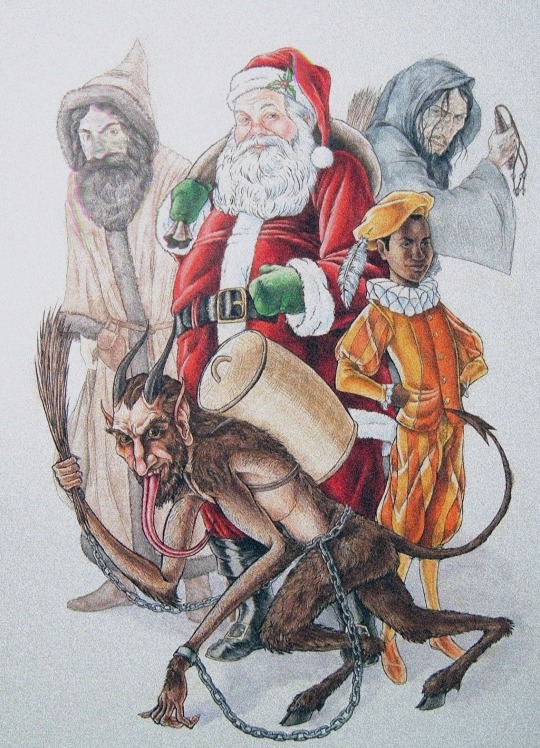
Art by Spearhafoc on Deviantart
A common motif in European Christmas lore is that when old St. Nick goes to deliver gifts to well-behave children he often doesn’t go alone. The Companions are the figures who would assist him in his role as a gift-giver, and they change a lot depending on the time period and local.
In theory, these companions are local variants of the same guy, a somber and darker figure that would punish the bad kids, while Nicholas himself would reward the good ones. Krampus, who I talked about in my last post, is one of these, and his characterization as a half-goat demon comes from the context of the alpine region. The context of the place in question and the way the legends about St. Nicholas are told there shape the form of the sidekick that comes with him. In some places the companion assumed the form of a terrifying old man, in others, he stays in the middle ground with Krampus, as scary man with horns.
Some of them came to a more positive light is recent times and are considered now the Robin to St. Nick’s Batman.
I will talk about three of them today.
Quick note, where’s my Christmas movie where Santa is a (Batman voice) “I work alone” type of hero and then a young wide-eyed sidekick comes in and says, “Teach me in the ways of Christmas, Santa!”. I would watch it
Knecht Ruprecht
“From out the forest I now appear;
To proclaim that Christmastime is here!
now speak, what is there here to be had?
Are there good children, are there bad?”
“Knecht Ruprecht”, Theodor Storm

In my last posts I made a mistake. I associate Krampus with Germany, but now, it seems like he’s more from the Austria and the Alpine region as a whole. Germans have the Knecht Ruprecht, and instead of being a half-goat demon from Hell, he’s a sinister man with a black beard bearing a black furry robe, a chain and bells along with a bundle of birch sticks to punish the naughty children. The word Knecht in German means servant or farmhand, so in English his name would be Servant Ruprecht or Farmhand Ruprecht, and you can even get a Rupert or Robert if you anglicized his name.
It seems that in traditional German Christmas lore, it’s the Christkind, a magical version of baby Jesus, who brings gifts on Christmas Eve. However, Saint Nicholas do appear, but only on December 5th, the eve of his feast, bringing along Ruprecht. St Nicholas would open the big book to see if the devil had written anything bad about the children. Then Knecht Ruprecht would ask them if they knew their prayers. Kids who had been good and could recite the Lord’s prayer would be given apples or nuts by Nicholas as a treat. Bad children would receive sticks, coal, or could even be stuffed in Ruprecht’s sack and be dragged away to never be seen again.
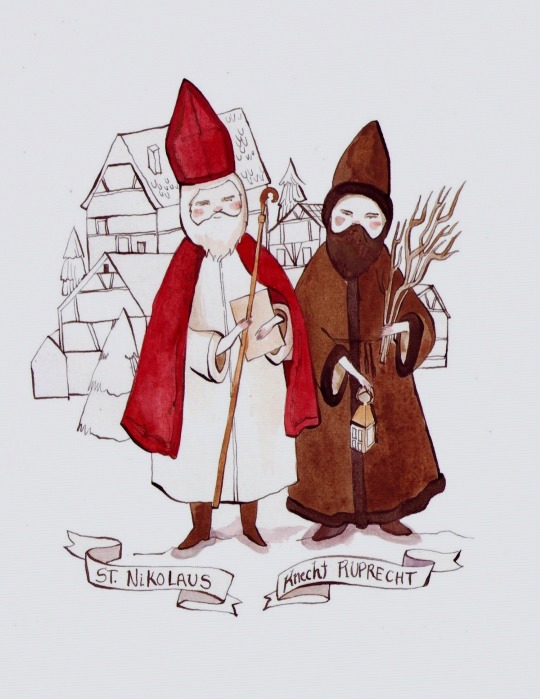
I don’t know if this is true, but during my research I learned that some German parents went to great lengths to teach their misbehaving kids a lesson. They actually had someone to take them away, and some even remember being taken out to the woods. Don’t mess around with Germans!
His backstory is nebulous. Remember what I told, variants of the same guy. In some tellings he is closer to Krampus, with horns in his head as a result. In others he is a wounded foundling that St Nicholas rescued and raised. And in others he is told to be the butcher from St. Nicholas’ lore, that would inspire our next companion.
Père Fouettard
French for, “Father Whipper”. One of the darkest and most vicious companions.

There’s a very dark legend about St. Nicholas. A butcher (in some versions an innkeeper) kills three children that were on their way to enroll in a religious boarding school. In some versions he and his wife drugged the kids, sliced their throats, cut them into pieces and put them in a salting tub. When St. Nicholas turned up at the door the butcher attempted to ingratiate himself to his visitor by offering him his best meat, the children. St Nicholas immediately discovered the horrible crime and brought the boys back to life and punished the butcher by forcing him to work alongside him for all eternity.

In France, it is Père Noël, Father Christmas, who distributes gifts to good children, generally on Christmas Eve, except in eastern France where St. Nicholas Day and the night of December 5th still are observed. He is traditionally accompanied by Père Fouettard.
Pere Fouettard is portrayed as a man with a creepy face, disheveled, messy hair, and a long white beard. He is often described as clothed in murky robes, covered in soot, wearing a scruffy hat and buckled shoes. He follows Père Noël/St. Nicholas from house to house, acting as his punisher, dispensing coal, and beatings to the naughty. In some tellings, he carries a wicker back-pack to carry naughty children away. It is also believed that Pere Fouettard tells St. Nicholas, which children misbehaved during the year, and consequently, they are deprived of the treat. Some even say that, he cuts out tongues of children who are caught lying.
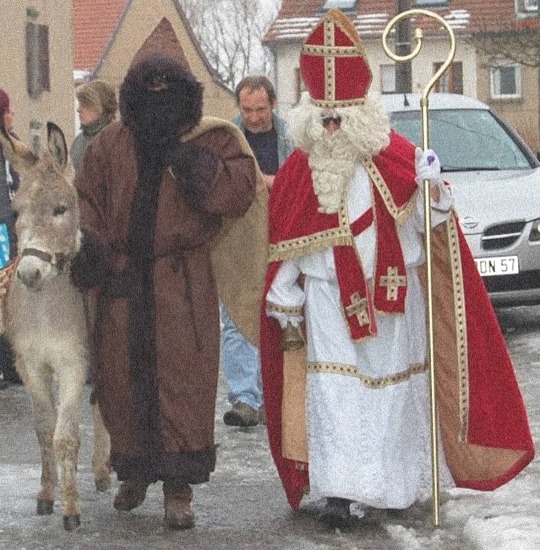
Why in the world St. Nick would trust a cannibal child killer to be near children is beyond me.
Zwarte Piet, “Black Pete”
Oh boy! You know where this is going!

Zwarte Piet is that type of character that the more you research, the worse it gets
Sinterklaas is the form that Saint Nicholas assumes in the Netherlands and Belgium, and he is the main source for the American Santa Claus.

In the first Saturday after 11 November, he arrives by a steamboat at a designated seaside town, coming from Spain. In the Netherlands this takes place in a different port each year, whereas in Belgium it always takes place in the city of Antwerp. The steamboat anchors, then Sinterklaas disembarks and parades through the streets on his white horse, welcomed by children cheering and singing traditional Sinterklaas songs. He then parades through schools, hospitals, and shopping centers until the evening of December 5th, where he would deliver gifts to the children.
I will admit, this sounds so much cooler and more fun than modern day Santa.
Sinterklaas has a sidekick, a moor from Spain, Zwarte Piet, the Black Pete, usually portrayed as a blackface caricature, wearing a colorful Renaissance attire in addition to curly wigs and bright red lipstick. His role is to be Nicholas’ servant, a rascal and a prankster, amusing children and distributing traditional sweets during parades and public events. In older lore he was said to act just like the other companions, punishing bad children with coal in their shoes and threatening to kidnap them.
Some older traditional Sinterklaas songs claim that he and Sinterklaas could even drag the naughty kids to their home in Spain, were they would force them to work in their workshop for an entire season or longer. They essentially used slave labor! 😬
Some link him and Sinterklaas to Odin, and Huggin and Munnin. Huginn and Muninn would often fly through the Nine Realms, bringing a report of who was good and who was bad back to Odin. So, the black guy's role may have come from Odin’s crows 😬
Others link him to Krampus and Krampus-like figures, evil demons who were show to be under the control of Saint Nicholas and the power of God. According to a theory firstly proposed by Karl Meisen, Zwarte Piet and many other companions, like Krampus, were inspired by these enslaved demons.
Zwarte Piet and many modern traditions about him and Sinterklaas came from a children's book written school teacher Jan Schenkman, in 1850. The book was titled Sint Nikolaas en zijn Knecht, "Saint Nicholas and his Servant". In Schenkman's version, the devil figure that followed St. Nicholas was changed to a Moorish helper.
More modern lore presents him as a more of a Robin-like figure, a more heroic and charismatic sidekick. He is said to be a Turkish orphan rescued by St Nick, or an Ethiopian slave freed by him. Or he is just completely whitewashed, and the dark skin is explained as the ashes and ambers from the chimneys.
He is very controversial, and said to be a remnant of colonialism, slavery and racism. Some say he may be even inspired by a slave brought by one member of Dutch Royal family in market in Cairo in the mid-19th century.
As far as I know, Netherlands is very divided into those who want to keep the tradition, and others who see him as racist stereotype. A lot of protests and acts of violence had come from this simple problematic character. It’s very common for neo-nazi groups who want to keep him as he is to brutally attack and threw racial slurs on those who want a revised version of the character or his removal from the holiday tradition altogether.
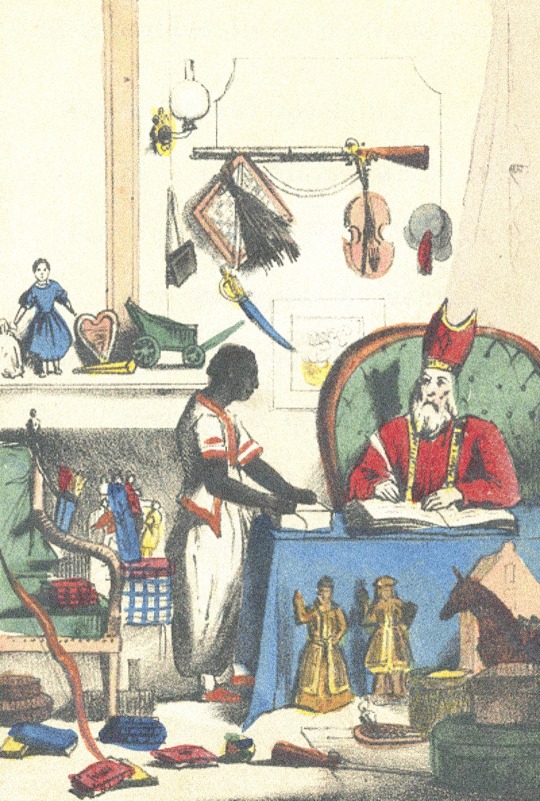
19 notes
·
View notes